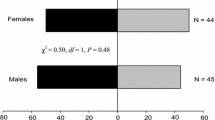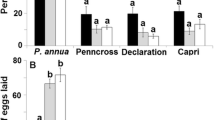Abstract
The behavioral responses of cowpea weevil,Callosobruchus chinensis to the leaf extracts of the aquatic weed, water hyacinth,Eichhornia crassipes (Mart) Solms. was evaluated by three different methods. The petroleum ether-soluble fraction ofE. crassipes induced high weevil attraction in all methods employed. The olfactometer assay provided a reading on weevil chemosensory responses, whereas the free-choice tests measured response and preference of weevils to the untreated or extract-treated food grain of their choice over a longer period. The extracts were also presented under no choice test conditions to assay them for the presence of oviposition stimulants. In all these methods the extracts of water hyacinth evoked a quick directional response. Another interesting feature is that the extract, besides producing attraction, also caused mortality of the insects.
Similar content being viewed by others
References
Dick, K.M., andCredland, P.F. 1984. Egg production and development of three strains ofCallosobruchus maculatus (Fab). (Coleoptera: Burchidae)J. Stored Prod. Res. 20:221–227.
Gomez, L.A., Rodriguez, J.G., Poneleit, C.G., Blake, D.F., Cecil, R., andSmith, J. 1983. Chemosensory responses of the rice weevil (Coleoptera: Curculionidae) to a susceptible and a resistant corn genotype.J. Econ. Entomol. 76:1044–1048.
Gopal, B., andSharma, K.P. 1981. Water Hyacinth. Hindasia Publ., Delhi, India.
Goswami, P.C., Nag, B., Sharma, A.K., Borthakur, A., Singh, M.D. andBaruah, J.N. 1983.Curr. Sci. 52:806–807.
Honda, H.L., Yamamoto, I., andYamamoto, R. 1969a. Attractant for rice weevil,Sitophilus zeamais (Coleoptera: Rhynchophoridae), from rice grains, I. Bioassay method for the attractancy of rice grains to rice weevils.Appl. Entomol. Zool. 4:23–31.
Jamil, K., Sighamony, S., andJyoti, K.N. 1988.Curr. Sci. 57:1002–1003.
Lambert, J.D.H., Gale, J., Arnason, J.T., andPhilogene, B.J.R. 1985. Bruchid control with traditionally used insecticide plantsHyptis spicigera andCassia nigricans.Insect. Sci. Applic. 6:167–170.
Sharma, R.N., andJoshi, V.N. 1977. Allomonic principles in Parthenium hysterophorus: Potential as insect control agents and role in the seed's resistance to serious insect depredation. Part II. The biological activity of parthenin on insects.Biovigyanam. 3:225–231.
Sharma, S.P., andDeora, R.K. 1980. Factors affecting production, release and response to female sex pheromones inSitophilus oryzae (L.) (Coleoptera: Curculionidae).Indian J. Exp. Biol. 8:463–465.
Stanic, V. andShulov. 1969. Olfactory response ofTrogoderma granarium adults (Col: Dermest) to odors of wheat, feces and some fecal components.J. Stored Prod. Res. 5:299–304.
Rani, U., andJamil, K. 1989. Effect of water hyacinth leaf extract on mortality, growth and metamorphosis of certain pests of stored products.J. Insect. Sci. Appl. 1989. (in press).
Yadava, R.L. 1971. Use of essential oilAcorus calamus L. as an insecticide against the pulse beetle,Bruchus chinensis L.Z. Angew. Entomol. 68:289–294.
Author information
Authors and Affiliations
Rights and permissions
About this article
Cite this article
Rani, U., Jamil, K. Chemosensory responses of cowpea weevil,Callosobruchus chinensis to an aquatic weed, water hyacinth,Eichhornia crassipes (Mart) Solms. J Chem Ecol 16, 1269–1275 (1990). https://doi.org/10.1007/BF01021025
Received:
Accepted:
Issue Date:
DOI: https://doi.org/10.1007/BF01021025




